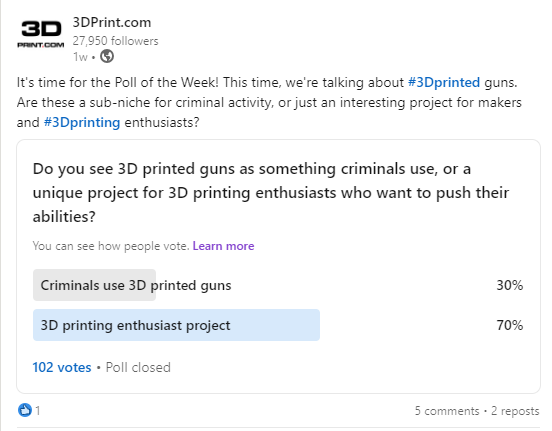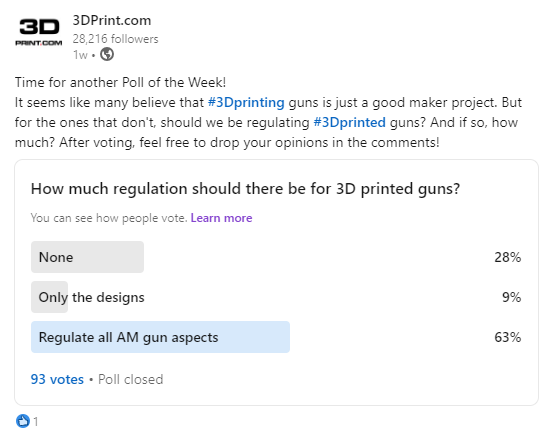One of the most controversial topics in the 3D printing industry, hands-down, is guns. It’s been a major point of contention for years, and people typically have very strong opinions on the subject. I’ve personally been asked if I feel bad about the fact that the technology I write about every day can be used to make weapons. So, I thought it would be a good subject for a two-part version of our Polls of the Week on LinkedIn. Are 3D printed guns really a threat? Do criminals go out and purchase 3D printers to make their own ghost guns? Or are they mostly just an interesting project for makers and enthusiasts?
The results of the first poll were overwhelmingly in favor of the latter, with 70% of participants voting that making guns was just a good 3D printing project. One person commented that the “enormous attention” given to the topic of 3D printed guns is “a joke when you talk to people outside the world of additive manufacturing,” because those who use guns for criminal purposes could just go to a store (or the black market?) and purchase one much more easily than buying a 3D printer and learning how to use it, plus the design software, post-processing, and everything else required to make such a complex item. As another person commented, the “biggest concern was always about undetectable firearms” and traceability, and he suggested that 3D printing material providers “insert a small amount of magnetic material” into their wares so they are detectable, similar to what the ceramic knife industry did.
“If you consider ghost guns that are 90 percent finished products and only require a small amount of machining to make them functional, how will this apply to 3d models??”
But is it that silly to think that criminals might appreciate a less obvious way to get their hands on weapons? 3D printed weapons and other accessories are already in use by militaries around the world, and some of these desktop 3D printers are so easy to use that even teenagers can manufacture guns in their basements. Maybe they’re not the highest quality firearms, but they are weapons nonetheless. We’re certainly not keeping 3D printed guns out of popular culture either—consider the use of the technology in the movie Hotel Artemis, or the fact that a terrorist character in the latest Call of Duty video game uses a 3D printed gun. It’s not a great look for the 3D printing industry, and could give people the wrong idea about how easy, or not, it is to print a gun at home.
Another commenter made an interesting point that different countries have different ideas on guns, noting that there isn’t really a gun culture in his home country of Australia, which has been against 3D printed guns for years. He said the only people in the country who possess firearms are farmers, hunters, and law enforcement, none of whom would consider using a 3D printed one. We reported an uptick in 3D printed gun arrests in Canada earlier this year, and European law enforcement agencies have been keeping a close eye on the rise of 3D printed guns across the continent. In August of 2023, Israeli Defense Forces confiscated 3D printers, and 3D printed guns, during routine counterinsurgency activities in the West Bank. The commenter then said that in the U.S., many people purchase guns for self-defense or as a hobby, and that as two thirds of the poll vote at the time were pointing at 3D printing guns as just a project, it was likely that “over two thirds of the voters… American.”
“So I can confidently say, that the results of this poll will not outwardly reflect the true thought process behind it.”
If that was in fact the case, then maybe voters in the next 3D printed gun poll we posted were not American. This time, I asked if we should be regulating 3D printed guns, and if so, how much.
28% of voters said we shouldn’t regulate 3D printed guns, while just 9% said we should only regulate the designs. The majority of voters said all aspects of 3D printed guns should be regulated. The U.S. Supreme Court upheld the authority of the Bureau of Alcohol, Tobacco, Firearms and Explosives (ATF) to regulate ghost guns, 3D printed or otherwise. But, as another commenter pointed out, while laws have been set to prevent the distribution of 3D designs for firearms, they are “written so broadly they would make sharing a gun maintenance guide, or even historical books that show how muskets work as illegal and the distribution of any such material considered gun trafficking. So a major overreach.”
I don’t know the answers to these questions, and I think it’s safe to say that, while people have their opinions, no one else does either.
Featured image courtesy of Trinidad and Tobago Police Service.
Subscribe to Our Email Newsletter
Stay up-to-date on all the latest news from the 3D printing industry and receive information and offers from third party vendors.
You May Also Like
3D Printing Webinar and Event Roundup: April 28, 2024
In this week’s 3D Printing Webinar and Event Roundup, the Ceramics Expo is taking place in Michigan, Stratasys continues its advanced training courses, and SPE is holding a Polymer Characterization...
Initial Speakers and Sponsors Announced for Additive Manufacturing Strategies 2025
Nearly a year away from the event, the Additive Manufacturing Strategies (AMS) 2025 conference is already beginning to take shape. Building upon the success of 2024’s summit, AMS has established...
HP & INDO-MIM Collaborate to Boost Metal 3D Printing in India
HP Inc. and INDO-MIM, a US- and India-based supplier of metal injection molding (MIM) powders and contract manufacturer, have announced that the two companies will collaborate to accelerate additive manufacturing...
One of US’s Largest Machine Tool Resellers to Offer Stratasys 3D Printing
In a key move for the additive manufacturing (AM) stalwart, Stratasys (Nasdaq: SSYS) has announced a strategic partnership with Select Additive Technologies, a division of Morris Group, Inc., which is...



































